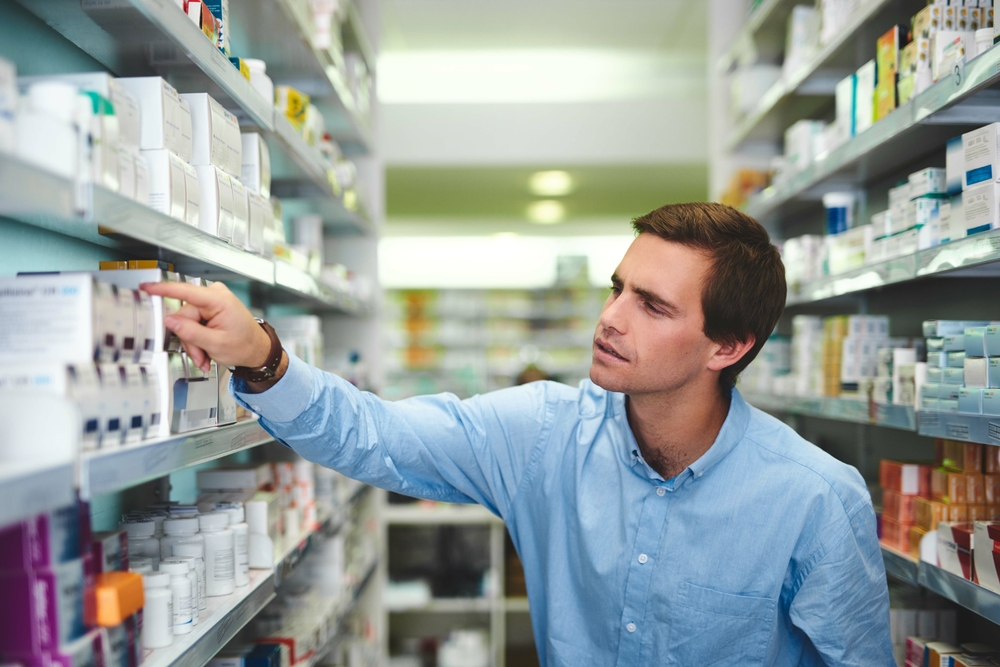
If you’ve ever walked into a pharmacy planning to grab one or two quick items and walked out with a surprisingly high bill, you’re not alone. Pharmacies are known for convenience, but that convenience often comes at a steep price. Certain pharmacy shelves consistently feature inflated costs compared to grocery stores, warehouse clubs, or online retailers. These pricing patterns aren’t accidental; they’re designed around shopper behavior, urgency, and impulse. Knowing which shelves to avoid can help you make smarter purchases and keep your healthcare spending under control.
1. Over-the-Counter Medications
The most obvious example of overpriced pharmacy shelves is the section with over-the-counter medications. Pain relievers, allergy pills, and cold remedies are often marked up 20% to 50% compared to big-box stores. Pharmacies count on convenience. People often buy these items when they’re sick, stressed, or in a hurry. The brand-name packaging and end-cap displays add to the illusion of quality, even when generic equivalents are available for much less. Shopping for these medications in bulk or online can significantly cut your healthcare costs without sacrificing effectiveness.
2. Vitamins and Supplements
Another pharmacy section where prices climb fast is the vitamins and supplements aisle. These products are marketed as essential to wellness (which isn’t always the case), which encourages impulse purchases. However, pharmacy shelves often carry premium brands with inflated prices, while similar formulas sell for much less elsewhere. Many pharmacies also use buy-one-get-one deals that make shoppers feel they’re saving when they’re actually overpaying. Buying vitamins from reputable online stores or discount retailers can help you get the same nutritional value for a fraction of the cost.
3. First Aid Supplies
The first aid aisle is a quiet budget trap on pharmacy shelves. Bandages, antiseptics, and gauze pads often cost more per unit than at grocery or dollar stores. Brands capitalize on urgency. If someone needs first aid, they’re less likely to compare prices. In many cases, the same manufacturer produces both the name-brand and store-brand versions, but the packaging alone justifies a higher price tag. Keeping these items stocked at home from cheaper bulk purchases can prevent expensive last-minute runs.
4. Beauty and Skincare Products
Beauty and skincare sections are some of the most profitable shelves, with markups that can surprise even savvy shoppers. From moisturizers to acne treatments, prices are often inflated due to brand positioning and convenience. Many pharmacies carry mid-tier brands at department store prices, banking on consumer trust in their “dermatologist-recommended” labels. However, those same products are frequently cheaper online or at warehouse stores. Comparing prices before buying skincare in a pharmacy can save you both money and disappointment.
5. Baby Care Items
Parents are frequent pharmacy shoppers, and stores know it. Diapers, wipes, formula, and baby medications often cost significantly more on pharmacy shelves than at supermarkets or discount retailers. Pharmacies use shelf placement and “trusted care” branding to target busy parents who need essentials quickly. Even small price differences per package add up over time for households with young children. Buying in bulk or through subscription services usually provides far better value than convenience-store pricing.
6. Convenience Snacks and Drinks
Near the checkout counter, pharmacy shelves are loaded with snacks, bottled drinks, and small household items. These impulse buys are intentionally placed for maximum visibility and maximum markup. A single granola bar or bottled water can cost two or three times what you’d pay at a grocery store. The layout encourages shoppers to grab something quick while waiting in line for prescriptions. Sticking to your shopping list and avoiding these “grab-and-go” temptations can easily save you several dollars per trip.
7. Seasonal Aisles and Gift Items
Pharmacies are masters at seasonal marketing, but those themed shelves are rarely a good deal. Whether it’s Valentine’s Day cards, Easter candy, or holiday decor, prices are often inflated because of limited availability and emotional appeal. Shoppers assume they’re getting convenience, but they’re paying for retail psychology. Seasonal clearance items might look discounted, but even then, they’re often priced higher than similar items at larger retailers. Planning ahead and buying seasonal goods elsewhere can save a surprising amount over the course of a year.
8. Personal Hygiene Products
Razors, deodorants, toothpaste, and shampoo are everyday necessities, but they come with a premium. These items are strategically positioned near eye level and bundled in “special” packs that don’t always offer true savings. Name-brand products dominate the shelves, pushing cheaper store brands out of sight. The result is that shoppers pay more for packaging and perceived quality rather than substance. Checking unit prices or buying multipacks elsewhere can make a noticeable difference in your monthly budget.
Smart Shopping Starts with Awareness
Pharmacies are convenient, but that convenience often hides inflated costs that add up fast. By recognizing which pharmacy shelves are priced higher (and why), you can plan your purchases strategically. Stocking up on staples from discount or bulk retailers, comparing prices online, and avoiding impulse buys can help you save significantly without compromising quality. The key is awareness: once you know how pricing psychology works, you’ll never see a “quick pharmacy stop” the same way again.
Which shelves do you find the most overpriced? Share your money-saving discoveries or favorite budget-friendly alternatives in the comments below.
What to Read Next…
- 8 Pharmacy Shelves That Stock Identical Generics Cheaper
- 6 Pharmacy Discounts That Shoppers Rarely Claim
- 12 OTC Products That Do Exactly the Same Thing for Less
- 8 Pharmacy Deals Hidden Behind the Counter
- 13 Store Checkout Lines That Steal Extra Cash
The post 8 Pharmacy Shelves Where Prices Always Run Higher appeared first on Grocery Coupon Guide.







